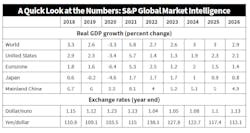S&P Global Sees a Slowing International Economy, But No U.S. Recession Yet
S&P Global Market Intelligence published an updated forecast that estimates global real GDP growth projected will slow to +2.7% in 2022 and +2.6% in 2023. Here is an executive summary of the forecast, available exclusively to EM subscribers.
World real GDP likely declined in the second quarter of 2022, but this expected outcome is not inevitably the beginning of a global recession. A period of subpar global growth is the most likely outcome. Absent new shocks, the global economy is projected to resume growth, although at a tepid annual pace of under +2% quarter-to-quarter in the third and fourth quarters of 2022.
Mainland China is reopening after lockdowns, and the Asia-Pacific region’s emerging markets are achieving solid growth even as the European and U.S. economies struggle. Worldwide, the transition from pandemic to endemic for COVID-19 is enabling growth in travel, tourism and other consumer service sectors that were hit hard during the 2020 recession. In advanced countries, household finances are generally in good shape, thanks to accumulated savings and asset appreciation in 2020–21. In a cycle dominated by consumer spending, households are positioned to drive the global expansion forward.
After a -3.3% contraction in 2020 and a +5.8% rebound in 2021, global real GDP growth is projected to slow to +2.7% in 2022 and +2.6% in 2023. This forecast is marked down by - 0.2% in 2022 and -0.3% in 2023. The 2022 downgrade is attributable to the U.S. economy’s weaker first-half performance, while the 2023 downgrade reflects the widespread impacts of more restrictive financial conditions. With the world’s population growing about +1% annually, our outlook implies solid gains in real per capita GDP and avoidance of a global recession.
In response to persistently high inflation and an upward drift in long-run inflation expectations, central banks are accelerating monetary policy tightening. While the 10-year U.S. Treasury yield has retreated from mid-June highs to around 3%, risk spreads have widened, raising financing costs for businesses and households. More emerging markets appear unable to raise new international bonds at sustainable cost levels, forcing them to seek alternative funding sources. Investors’ flight to safety would likely mean continued strength in the U.S. dollar and elevated risks for emerging markets that depend on capital inflows to finance trade and fiscal deficits.
Housing markets are especially vulnerable in the current environment.
Low mortgage rates and increased mobility with the work-from-home trend have fueled housing bubbles around the world. Rising mortgage rates and inflated home prices have hurt affordability, which reduced demand. The resulting market corrections will have adverse consequences for household net worth, residential construction and consumer durables spending. Nonresidential building construction is also sensitive to interest rates and could see further declines in areas with high vacancies.
With commodity prices falling, downstream inflation is nearing an inflection point.
In response to rising interest rates, U.S. dollar appreciation, and recession fears, a broad retreat in industrial and agricultural commodity prices is underway. The retreat in commodity prices is filtering downstream, causing inflation in prices of intermediate goods to slow globally. Evidence of decelerating prices of finished goods will become more pervasive in the final quarter of 2022. Global consumer price inflation is projected to ease from +7.3% in 2022 to +4.2% in 2023 and +2.7% in 2024.
The U.S. economy has stalled, but it’s not in recession — yet.
U.S. real GDP declined at an annual rate of -1.6% quarter-to-quarter in the first quarter, pulled down by a sharp rise in imports and a decline in exports. We expect a similar contraction in the second quarter, owing to a sharp reduction in inventory accumulation. This episode is unlikely to meet the broad criteria for a recession set by the National Bureau of Economic Research, as it’s difficult to square the real GDP losses with notable gains in employment, incomes and personal consumption.
Yet, the path forward will be difficult. The Federal Reserve has signaled a willingness to raise interest rates enough to slow inflation to its +2% target, even if the result is a recession. The boom in housing markets is reversing, and businesses will likely rein in capital spending and hiring plans. Real GDP growth is projected to slow from +5.7% in 2021 to just +1.4% in 2022 and +1.3% in 2023 before picking up to +1.9% in 2024. With real GDP growth running below potential, the unemployment rate will rise from 3.6% in June to a high of near 5% in 2024.
High energy costs are pushing Western Europe toward recession.
Our July forecast already incorporates mild second-quarter contractions in real GDP in the United Kingdom, Italy, Spain and the Netherlands. With inflation surprising on the upside, the central banks are stepping up the pace of monetary policy tightening. While a rebound in tourism and consumer services might give the region a slight lift in the summer quarter, another setback is likely in the fourth quarter, given unreliable energy supplies
Exceptionally high natural gas and electricity prices will damage industrial competitiveness in Germany and other manufacturing centers. The destructive Russia-Ukraine war will likely drag on through 2022, deflating consumer and business confidence across Europe. Eurozone real GDP growth is projected to slow from +5.4% in 2021 to +2.5% in 2022 and +1.2% in 2023 before improving to +2% in 2024.
Mainland China’s economy is tentatively recovering from COVID-19 lockdowns.
Mainland China’s real GDP declined -2.6% quarter-to-quarter in the second quarter, resulting in +0.4% year-on-year (y/y) growth that was supported by infrastructure spending and investment by state-owned firms. Monthly data suggest a broadening recovery in June. The government’s dynamic zero-COVID policy will remain in place through at least March 2023, preventing a return to normalcy and limiting the effectiveness of economic stimulus. The property market remains in recession, and declining land sales are hurting local government finances. Real GDP growth is projected to slow from +8.1% in 2021 to +4% in 2022 before strengthening to +5.2% in 2023.
Asia Pacific will dominate global growth as other regions falter.
Resilient growth in the Asia-Pacific region is key to our outlook of sustained global economic growth in 2022 and 2023. This region will likely account for 53% of global real GDP growth in 2022 and an exceptional 62% in 2023. Its contribution is projected to average about 56% over the next decade. After slowing from +6.2% in 2021 to +3.9% in 2022, Asia Pacific’s real GDP growth is projected to settle at +4.4% in both 2023 and 2024. India, Indonesia, Vietnam and the Philippines will likely achieve growth rates of +5% to +7%.
This performance reflects strong intraregional growth dynamics related to regional free-trade agreements, efficient supply chains, competitive costs and steady inflows of foreign direct investment. The region is also benefiting from strong pent-up demand for semiconductors and autos. Parts of the region experienced later waves of COVID-19 and are now experiencing robust recoveries following the easing of pandemic restrictions.
Bottom line.
While the global economy is expected to avert a recession, business conditions will be increasingly difficult in the year ahead as financial markets tighten. The risk of recession remains high — in the 40% to 50% range in major economies. Our next forecast will likely include downward revisions in interest rate–sensitive sectors such as housing, consumer durables and business capital spending
— Sara Johnson, executive director, Economic Research,
S&P Global Market Intelligence

